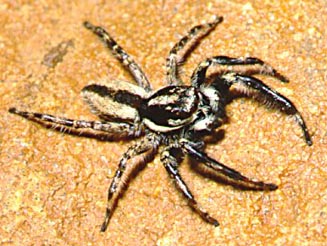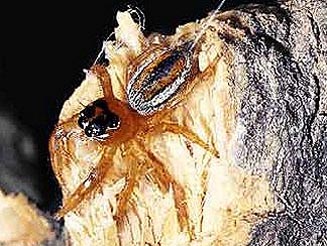|
Family: Salticidae (jumping spiders)
Life
> Eukaryotes
>
Opisthokonta >
Metazoa
(animals) > Bilateria > Ecdysozoa > Panarthropoda > Tritocerebra >
Arthropoda > Arachnomorpha > Cheliceriformes > Chelicerata > Euchelicerata
> Arachnida > Araneae
> Araneomorpha
Commonly called Jumping spiders, the Salticidae are also affectionately
referred to as Charlies, Herbies or Salties. They are very common around the home
and their anthropomorphic nature endears them to most people. The family name is derived
from the Latin "salto" which means to
dance with pantomimic gestures (See mating behaviour below). This is the largest spider
family and includes more than 5000 species worldwide. There are 46 genera in South Africa.
These spiders are harmless to man although there have been complaints where this comical,
engaging animal has been accused of nasty bites.
This family is easily identified by the 2 large anterior median (front
central, like 2 headlights) eyes. These binocular, telescopic eyes can identify detail and
colour for up to 20 body-lengths making the spider a very successful hunter. The 6 other
eyes detect movement and prey. The 2 wide-angled secondary eyes detect object up to
30-40cms. At about 20cms it turns to face the object, at 8-10cms is able to identify, at
3-4cms it will start to stalk and at 1-2cms the attack is launched.
 |
 |
| Salticidae. [image
N. Larsen ©] |
Salticidae with "bungee" silk
thread attached. [image N. Larsen ©] |
The various species either walk or jump but the salticids are the
bungee jumpers of the spider world. To catch flying prey, they simply attach silk to a
substrate and leap into the air. Should they miss a landing site, they simply haul
themselves back up the launch site and reuse the bungee. They vary in size, 3 to 17mm and
the Cape species rarely exceed 10mm. They are diurnal (daytime) cursorial (running)
hunters. Generally, they are squat-bodied with short legs but there are some species that
are slender where they mimic certain insects. The legs are not especially muscled for
jumping but instead a jump is propelled by an explosive release of hydraulic pressure in
the 4 hind legs. Unlike web-bound spider that have 3 claws, the salticids have 2 claws
plus a scopulae pad (tuft of hair) that enables to adhere to various surfaces.
The integument (skin) varies from glabrous (hairless) to
hirsute (hairy). Depending on the spider species and the animal that is being mimicked, they are
often cryptically or attractively patterned.
The male is usually more slender and often looks totally different
(sexually dimorphic) in shape and colour. This chapter would be incomplete without a
reference to the courtship of these spiders, not only from an interest point of view but
it will also explain the Latin derivation of the family name mentioned above. Interesting
and amusing studies have been done on mating dances carried out by male spiders which
consist of ostentacious and ridiculous weaving and lurching accompanied by waving and
signalling with the palps. The antics are sometimes mimicked by the females
perhaps as a signal to the male that she has got into the swing of things and is
available to mate. Some of the males'
repetitive palp movements are thought to mesmerise or hypnotize the female, reducing the
risk of attack. The courting male jumping spider must dance before his mistress and it seems that the male makes desperate
attempts to impress the female with his dancing repertoire while the female follows every
step with critical interest.
Links
Publications
Text by Norman Larsen ©. |
